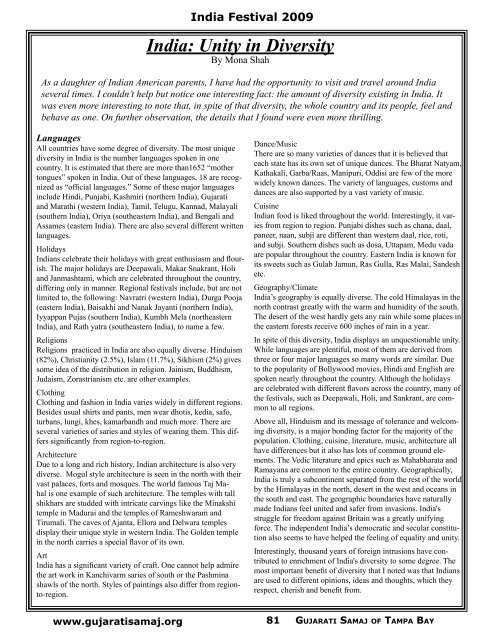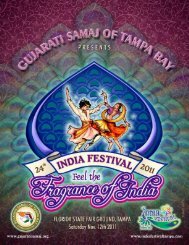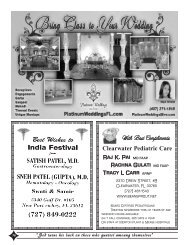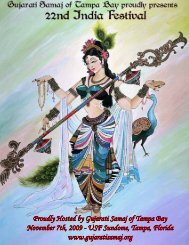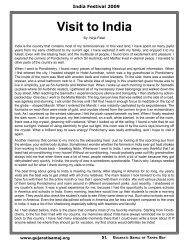India Festival Souvenir Book-2009 (Part 4)
India Festival Souvenir Book-2009 (Part 4)
India Festival Souvenir Book-2009 (Part 4)
Create successful ePaper yourself
Turn your PDF publications into a flip-book with our unique Google optimized e-Paper software.
<strong>India</strong> <strong>Festival</strong> <strong>2009</strong><br />
<strong>India</strong>: Unity in Diversity<br />
By Mona Shah<br />
As a daughter of <strong>India</strong>n American parents, I have had the opportunity to visit and travel around <strong>India</strong><br />
several times. I couldn’t help but notice one interesting fact: the amount of diversity existing in <strong>India</strong>. It<br />
was even more interesting to note that, in spite of that diversity, the whole country and its people, feel and<br />
behave as one. On further observation, the details that I found were even more thrilling.<br />
Languages<br />
All countries have some degree of diversity. The most unique<br />
diversity in <strong>India</strong> is the number languages spoken in one<br />
country. It is estimated that there are more than1652 “mother<br />
tongues” spoken in <strong>India</strong>. Out of these languages, 18 are recognized<br />
as “official languages.” Some of these major languages<br />
include Hindi, Punjabi, Kashmiri (northern <strong>India</strong>), Gujarati<br />
and Marathi (western <strong>India</strong>), Tamil, Telugu, Kannad, Malayali<br />
(southern <strong>India</strong>), Oriya (southeastern <strong>India</strong>), and Bengali and<br />
Assames (eastern <strong>India</strong>). There are also several different written<br />
languages.<br />
Holidays<br />
<strong>India</strong>ns celebrate their holidays with great enthusiasm and flourish.<br />
The major holidays are Deepawali, Makar Snakrant, Holi<br />
and Janmashtami, which are celebrated throughout the country,<br />
differing only in manner. Regional festivals include, but are not<br />
limited to, the following: Navratri (western <strong>India</strong>), Durga Pooja<br />
(eastern <strong>India</strong>), Baisakhi and Nanak Jayanti (northern <strong>India</strong>),<br />
Iyyappan Pujas (southern <strong>India</strong>), Kumbh Mela (northeastern<br />
<strong>India</strong>), and Rath yatra (southeastern <strong>India</strong>), to name a few.<br />
Religions<br />
Religions practiced in <strong>India</strong> are also equally diverse. Hinduism<br />
(82%), Christianity (2.5%), Islam (11.7%), Sikhism (2%) gives<br />
some idea of the distribution in religion. Jainism, Buddhism,<br />
Judaism, Zorastrianism etc. are other examples.<br />
Clothing<br />
Clothing and fashion in <strong>India</strong> varies widely in different regions.<br />
Besides usual shirts and pants, men wear dhotis, kedia, safo,<br />
turbans, lungi, khes, kamarbandh and much more. There are<br />
several varieties of saries and styles of wearing them. This differs<br />
significantly from region-to-region.<br />
Architecture<br />
Due to a long and rich history, <strong>India</strong>n architecture is also very<br />
diverse. Mogul style architecture is seen in the north with their<br />
vast palaces, forts and mosques. The world famous Taj Mahal<br />
is one example of such architecture. The temples with tall<br />
shikhars are studded with intricate carvings like the Minakshi<br />
temple in Madurai and the temples of Rameshwaram and<br />
Tirumali. The caves of Ajanta, Ellora and Delwara temples<br />
display their unique style in western <strong>India</strong>. The Golden temple<br />
in the north carries a special flavor of its own.<br />
Art<br />
<strong>India</strong> has a significant variety of craft. One cannot help admire<br />
the art work in Kanchivarm saries of south or the Pashmina<br />
shawls of the north. Styles of paintings also differ from regionto-region.<br />
Dance/Music<br />
There are so many varieties of dances that it is believed that<br />
each state has its own set of unique dances. The Bharat Natyam,<br />
Kathakali, Garba/Raas, Manipuri, Oddisi are few of the more<br />
widely known dances. The variety of languages, customs and<br />
dances are also supported by a vast variety of music.<br />
Cuisine<br />
<strong>India</strong>n food is liked throughout the world. Interestingly, it varies<br />
from region to region. Punjabi dishes such as chana, daal,<br />
paneer, naan, subji are different than western daal, rice, roti,<br />
and subji. Southern dishes such as dosa, Uttapam, Medu vada<br />
are popular throughout the country. Eastern <strong>India</strong> is known for<br />
its sweets such as Gulab Jamun, Ras Gulla, Ras Malai, Sandesh<br />
etc.<br />
Geography/Climate<br />
<strong>India</strong>’s geography is equally diverse. The cold Himalayas in the<br />
north contrast greatly with the warm and humidity of the south.<br />
The desert of the west hardly gets any rain while some places in<br />
the eastern forests receive 600 inches of rain in a year.<br />
In spite of this diversity, <strong>India</strong> displays an unquestionable unity.<br />
While languages are plentiful, most of them are derived from<br />
three or four major languages so many words are similar. Due<br />
to the popularity of Bollywood movies, Hindi and English are<br />
spoken nearly throughout the country. Although the holidays<br />
are celebrated with different flavors across the country, many of<br />
the festivals, such as Deepawali, Holi, and Sankrant, are common<br />
to all regions.<br />
Above all, Hinduism and its message of tolerance and welcoming<br />
diversity, is a major bonding factor for the majority of the<br />
population. Clothing, cuisine, literature, music, architecture all<br />
have differences but it also has lots of common ground elements.<br />
The Vedic literature and epics such as Mahabharata and<br />
Ramayana are common to the entire country. Geographically,<br />
<strong>India</strong> is truly a subcontinent separated from the rest of the world<br />
by the Himalayas in the north, desert in the west and oceans in<br />
the south and east. The geographic boundaries have naturally<br />
made <strong>India</strong>ns feel united and safer from invasions. <strong>India</strong>'s<br />
struggle for freedom against Britain was a greatly unifying<br />
force. The independent <strong>India</strong>’s democratic and secular constitution<br />
also seems to have helped the feeling of equality and unity.<br />
Interestingly, thousand years of foreign intrusions have contributed<br />
to enrichment of <strong>India</strong>'s diversity to some degree. The<br />
most important benefit of diversity that I noted was that <strong>India</strong>ns<br />
are used to different opinions, ideas and thoughts, which they<br />
respect, cherish and benefit from.<br />
www.gujaratisamaj.org<br />
81 Gujarati Samaj of Tampa Bay


